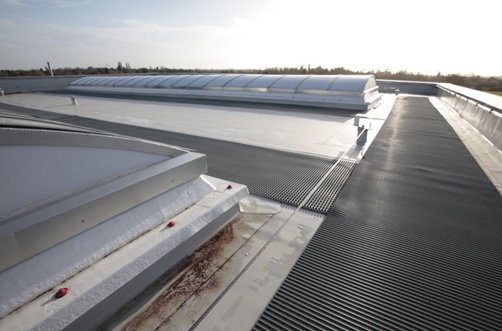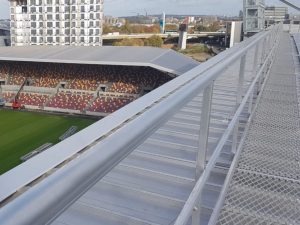Walkway

Description
Walkways are usually installed on roofs to improve safe access around the roof. They are generally used for one of the following reasons; demarcation, anti-slip, anti-trip, levelling or roof protection.
There are two main types of roof walkway:
- Laid-Out – flexible grill, supplied in a roll, which is primarily used as demarcation and/ or anti-slip on membrane roofs, but is often not fixed or bonded to the membrane.
- Supported – fabricated or modular, steel or aluminium structures, primarily used as anti-trip and/ or levelling. They can be installed with guard rails on both, one or neither sides.
Applicable UK Standards & Guidance
Safety of machinery – Permanent means of access to machinery – Part 2: Working platforms and walkways
Prefabricated accessories for roofing — Installations for roof access — Walkways, treads and steps
Levels of Safety
Walkways which are designed and installed in compliance with standards offer simple to use safe access around roof areas, with few restrictions and without the need for specific competencies or PFPE. Guard rails should be provided wherever there is a possibility of falling more than 500mm.
Design Considerations
Generally, walkways should be 800mm wide, but for infrequently accessed maintenance areas 600mm wide is acceptable.
Open mesh platforms provide good slip resistance in all weathers, but if objects could be dropped through the mesh onto people below, then the mesh apertures should be reduced.
The physical and chemical compatibility of the walkway system with the roof structure and type should be checked.
User Considerations
There are few restrictions or specific requirements for the safe use walkways, other than general safe practice when working in exposed maintenance areas.
The load capacity of the walkway should be checked if more than 2 or 3 persons will use it at the same time or if materials are to be carried and/ or stored on it.
Inspection
Provision & Use of Work Equipment Regulations (PUWER)
Regulation 6 requires that inspections of work equipment are made and that records of the inspections are maintained.
Workplace (Health Safety & Welfare) Regulations
Regulation 5 requires the employer and/or the person in control of premises must maintain the workplace and contents so that they remain safe and without risk to health and fully comply with the detailed requirements of the regulations.


